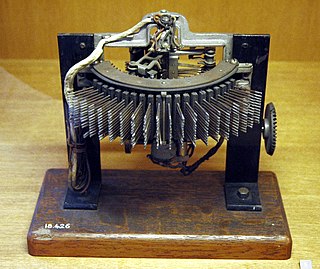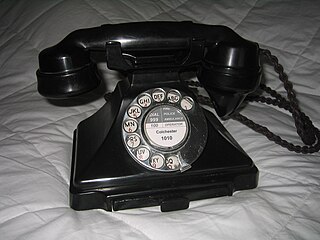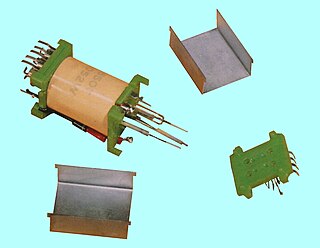Related Research Articles
The General Electric Company (GEC) was a major British industrial conglomerate involved in consumer and defence electronics, communications, and engineering. The company was founded in 1886, was Britain's largest private employer with over 250,000 employees in the 1980s, and at its peak in the 1990s, made profits of over £1 billion a year.

The Strowger switch is the first commercially successful electromechanical stepping switch telephone exchange system. It was developed by the Strowger Automatic Telephone Exchange Company founded in 1891 by Almon Brown Strowger. Because of its operational characteristics, it is also known as a step-by-step (SXS) switch.
The Plessey Company plc was a British electronics, defence and telecommunications company. It originated in 1917, growing and diversifying into electronics. It expanded after World War II by acquisition of companies and formed overseas companies.
Automatic Electric Company was an American telephone equipment supplier primarily for independent telephone companies in North America, but also had a worldwide presence. With its line of automatic telephone exchanges, it was also a long-term supplier of switching equipment to the Bell System, starting in 1919. The company was the largest manufacturing unit of the Automatic Electric Group. In 1955, the company was acquired by General Telephone and Electronics (GT&E). After numerous reorganization within GTE, the companies assets it came under the umbrella of Lucent in the 1990s, and subsequently part of Nokia.

The director telephone system was a development of the Strowger or step-by-step (SXS) switching system used in London and five other large cities in the UK from the 1920s to the 1980s.
System X is the digital switching system installed in telephone exchanges throughout the United Kingdom, from 1980 onwards.
The Marconi Company was a British telecommunications and engineering company that did business under that name from 1963 to 1987. Its roots were in the Wireless Telegraph & Signal Company founded by Italian inventor Guglielmo Marconi in 1897, which underwent several changes in name after mergers and acquisitions. The company was a pioneer of wireless long distance communication and mass media broadcasting, eventually becoming one of the UK's most successful manufacturing companies. In 1999, its defence equipment manufacturing division, Marconi Electronic Systems, merged with British Aerospace (BAe) to form BAE Systems. In 2006, financial difficulties led to the collapse of the remaining company, with the bulk of the business acquired by the Swedish telecommunications company, Ericsson.

Marconi Communications, the former telecommunications arm of Britain's General Electric Company plc (GEC), was founded in August 1998 through the amalgamation of GEC Plessey Telecommunications (GPT) with other GEC subsidiaries: Marconi SpA, GEC Hong Kong, and ATC South Africa.
GEC Plessey Telecommunications (GPT) was a British manufacturer of telecommunications equipment, notably the System X telephone exchange. The company was founded in 1988 as a joint venture between GEC and the British electronics, defence and telecommunications company Plessey. The next year, after a joint holding company of GEC and the German conglomerate Siemens acquired Plessey, GPT was converted into a 60/40 GEC/Siemens joint venture. The GPT name ceased to be used in the mid-1990s, and in 1998 the company was amalgamated into Siemens Communications.

Siemens Brothers and Company Limited was an electrical engineering design and manufacturing business in London, England. It was first established as a branch in 1858 by a brother of the founder of the German electrical engineering firm Siemens & Halske. The principal works were at Woolwich where cables and light-current electrical apparatus were produced from 1863 until 1968. The site between the Thames Barrier and Woolwich Dockyard has retained several buildings of historic interest. New works were built at Stafford in 1903 and Dalston in 1908.
System Y is the terminology used by BT, the main operator of the telephone network in the United Kingdom, to refer to the Ericsson AXE digital switching system.
Standard Telephones and Cables Ltd was a British manufacturer of telephone, telegraph, radio, telecommunications, and related equipment. During its history, STC invented and developed several groundbreaking new technologies including pulse-code modulation (PCM) and optical fibres.
Siemens Communications was the communications and information business arm of German industrial conglomerate Siemens AG, until 2006. It was the largest division of Siemens, and had two business units – Mobile Networks and Fixed Networks; and Enterprise.

TXE, was a family of telephone exchanges developed by the British General Post Office (GPO), designed to replace the ageing Strowger switches.
TXK was a range of Crossbar exchanges used by the British Post Office telephone network, subsequently BT, between 1964 and 1994. TXC was used as the designation at first, but this was later changed as TXC sounded too much like TXE the code used for later electronic exchanges. Prior to this the GPO had standardised on Strowger for automatic switching and had resisted the adoption of Crossbar, preferring to wait for its electronic switching research to bear fruit. The development of electronic systems however took longer than anticipated and the British equipment manufacturers, particularly Automatic Telephone & Electric (ATE), which later became part of the Plessey group feared that continuing to focus the bulk of their production on Strowger equipment would harm their export sales as Crossbar had already become popular throughout the world.

The rotary machine switching system, or most commonly known as the rotary system, was a type of automatic telephone exchange manufactured and used primarily in Europe from the 1910s. The system was developed and tested by AT&T's American engineering division, Western Electric, in the United States, at the same time when Western Electric was also developing the Panel switch. When AT&T selected the Panel System for large American exchanges, development and sales of the No. 7-A Machine Switching System, its formal commercial name, were transferred to Western Electric's international division in Belgium. In Europe and other continents the system was met with considerable commercial success.

The General Post Office (GPO) was the state postal system and telecommunications carrier of the United Kingdom until 1969. Before the Acts of Union 1707, it was the postal system of the Kingdom of England, established by Charles II in 1660. Similar General Post Offices were established across the British Empire. In 1969 the GPO was abolished and the assets transferred to The Post Office, changing it from a Department of State to a statutory corporation. In 1980, the telecommunications and postal sides were split prior to British Telecommunications' conversion into a totally separate publicly owned corporation the following year as a result of the British Telecommunications Act 1981. For the more recent history of the postal system in the United Kingdom, see the articles Royal Mail and Post Office Ltd.
Sir John Allen Clark was managing director of the British Plessey Company, an electronics and telecommunications group built up by his father, Allen George Clark. His career with Plessey was dominated by a battle with Arnold Weinstock of GEC for control of the company together with English Electric from the 1960s. This culminated in the late 1980s with the takeover and break-up of Plessey.
Dialling is the action of initiating a telephone call by operating the rotary dial or the telephone keypad of a telephone.
References
- 1 2 "Automatic Telephone and Electric Co". Graces Guide. Archived from the original on 3 July 2012. Retrieved 31 March 2021.
- ↑ Robertson 1947, pp. 94–98.
- ↑ "UK TELEPHONE HISTORY". www.britishtelephones.com.
- 1 2 Robertson 1947, pp. 158–160.
- ↑ Robertson 1947, pp. 161–165.
- ↑ "Automatic Telephone Manufacturing Co". Graces Guide. Archived from the original on 5 July 2012. Retrieved 31 March 2021.